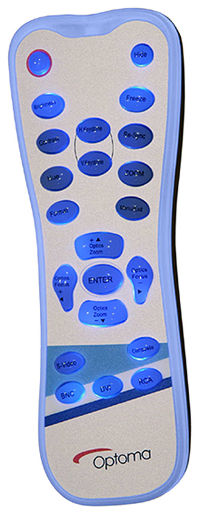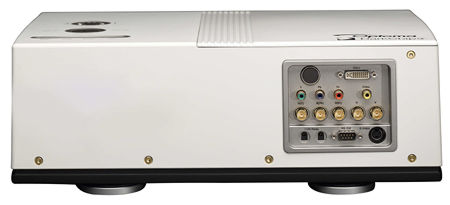Optoma H79 DLP Projector Page 2
 On the plus side, the H79 offers a complete set of signal adjustments for the analog inputs, including horizontal and vertical picture, phase, and frequency adjustments. These controls allow each analog source to be fine-tuned so it can be perfectly placed on the screen.
On the plus side, the H79 offers a complete set of signal adjustments for the analog inputs, including horizontal and vertical picture, phase, and frequency adjustments. These controls allow each analog source to be fine-tuned so it can be perfectly placed on the screen.
The H79's advanced menu also offers extremely useful color-adjustments, including the RGB brightness and contrast controls a trained technician will need if you elect to do a complete calibration. At first, I noticed that the DVI and component inputs' color balances from the same sources did not match. The analog component input was noticeably and objectionably green. With the advanced color adjustments, I was able to correct the analog input's color so it closely matched the DVI input. Without the H79's advanced color adjustments, the analog source's color balance would have been less than acceptable.
The menus also allow for direct adjustment of white peaking. I fantasize that someday owner's manuals will tell users not only what each control does but also how to set them properly. The H79's owner's manual states, "If you prefer a stronger image, adjust toward the maximum setting. For a smoother, more natural image, adjust toward the minimum setting."
A better way to properly set the white peaking level would be to start with the control at minimum and use the contrast control to find the setting that causes near-peak whites to crush into the pure whites. Then back off a notch. A multi-step gray scale pattern from a test disc (such as Avia or Digital Video Essentials), or even a scene with white, textured clouds, are good sources for this. (There should be detail in the clouds and not simply a uniform, solid mass of white—assuming the scene was photographed and transferred properly.) If you still demand a brighter picture after the contrast level is set correctly, try gradually increasing the white peaking control until just before the brightest whites start to crush together again.
Many a good projector has been ruined by a bad remote. Fortunately, the H79 is not one of them. Push any button on the remote and all of its backlit buttons emit strong blue light. It's not bright enough to double as a flashlight during emergencies, but it still ranks as one of the more useable remotes I've seen for blackened rooms. Input selection, format, focus, zoom, and keystone adjustments can be directly accessed from the remote. Four nice, large directional buttons surround the centrally located Enter button to control the H79's hierarchical menus. Occasionally, the H79 failed to respond to its remote when an especially high-brightness scene was on the screen, but a majority of the time, it quickly accepted commands.
Seeing and Believing
I don't particularly enjoy getting headaches from eyestrain. Every single-chip DLP projector I've reviewed in the past has necessitated the ingestion of large doses of aspirin after more than two hours of viewing time. Given this track record, I was not looking forward to my time with the H79.
As the magic two-hour mark approached during my first full evening of viewing, my thoughts turned to the family-sized bottle of aspirin and glass of water located next to my remote controls. After the three hour mark came and went without the slightest feelings of discomfort, I began to speculate about why the H79 was able to create a less-fatiguing image. I suspect its 8-segment color wheel combined with the 5x rotation speed is fine enough and fast enough so my brain and optical processing systems don't have to work as hard as with previous DLP projectors. Even though I could still occasionally see rainbow effects, especially during nighttime scenes where streetlights dot a dark background, the H79 did not induce the almost migraine-like symptoms of earlier DLP projectors. Whatever the reason, it's certainly a pleasure to be able to experience a single-chip DLP projector without pain.
As I mentioned earlier, it didn't take long to discover that the DVI picture quality vastly exceeded what can be gleaned from a component input. Whether it was 480p direct from the Lexicon RT-20 universal player, 720p HD material from the Samsung SIR-T165 DirecTV receiver, or 480i upconverted to 720p through a Faroudja NR processor, the DVI input bested all these analog sources handily. Not only did DVI have far less video noise, grain, and edge ghosting, but it also produced a noticeably sharper picture with more color variations and superior depth recreation. On the Star Trek Voyager DVDs, I could see where the makeup and prosthetic effects were less than perfect, and I marveled at the crew's myriad of different complexions, from Tuvak's dark umber tones to Seven of Nine's Nordic glow to Tom Paris' pasty WASP indoor tan.
The H79 even bested my longtime reference SIM2 Millennium 800 CRT projector in sharpness and lack of extraneous video noise, at least when the H79 was fed from DVI sources. Sure the SIM2 CRT had blacker blacks, but those blacks didn't have any more picture information than the H79. When set up properly, the DLP projector had just as much contrast and snap even on low-contrast and backlit scenes. On full-brightness outdoor scenes, the H79's superior brightness capabilities produced a far more realistic and arresting image.
The Millennium 800 was also crippled by its lack of DVI inputs. All the shortcomings I noticed with analog component sources on the H79 were painfully obvious on the Millennium 800, but unlike the H79, I couldn't switch to DVI to ameliorate them. On well-done transfers such as Shakespeare in Love and The Merchant of Venice (I've been feeling Elizabethan lately), detail, color fidelity, and depth recreation were so much better on the H79 that I had to sadly admit to myself that the Millennium 800's days as my personal reference are numbered.

Earlier I mentioned that Optoma claims only 23dB of noise from the H79. What does this mean exactly? In my room, the H79 qualifies as the quietest projector I've ever heard. It's even quieter than the Millennium 800 and far quieter than any other single-chip DLP projector I've reviewed. This lower noise level makes it possible to hear subtle sonic details at lower volume settings, which translates into less listening fatigue. I place projectors behind and above my listening position, so the rear channels especially benefited from the H79's lower noise level. Subtle surround effects, such as the rain falling during the trailer park scenes in Hedwig and the Angry Inch, had far greater realism. Rain splatters integrated more convincingly with the front channels to create a seamless, spatially encompassing soundfield.
Final Score
J. Gordon Holt, founder of Stereophile, once admitted to me during an interview that the reviews he most regretted were those in which he was overly enthusiastic about a new technology. I have long taken his admonitions to heart. Without some journalistic caution, it would be far too easy to gush about the Optoma H79.
To my mind—and eyes—the H79 qualifies as the first single-chip DLP that delivers acceptable home theater performance. Not only can it produce a stunning, virtually noise-free picture through its DVI inputs, but it does so without inflicting visual fatigue even after more than five hours of continuous critical viewing. Sure, it occasionally displays rainbow artifacts, and it doesn't have as black a black as a good CRT projector, but its wide contrast range, exemplary shadow detail, superb color delicacy, and extremely low mechanical noise level make it hard to deny its seductive allure.
If you have been a longtime holdout against single-chip DLP technology, the H79 will challenge your long-held opinions and biases against DLP projectors. In the end, I can offer no higher praise than this simple phrase: "I could live with it." When you factor in its price (and the street prices we've seen on this projector are exceptionally enticing), the H79 ranks as nothing short of the most impressive single-chip DLP projector I've ever seen. If you buy any other similarly priced projector without auditioning a H79, you are making a very big mistake. This is one giant-killer of a projector.
Highs and Lows
Highs
• Quiet
• Low fatigue even after many hours of viewing
• Color control for RGB contrast and brightness
Lows
• Color-temperature settings not related to any specific color temperature
• Some rainbow effects still visible























































